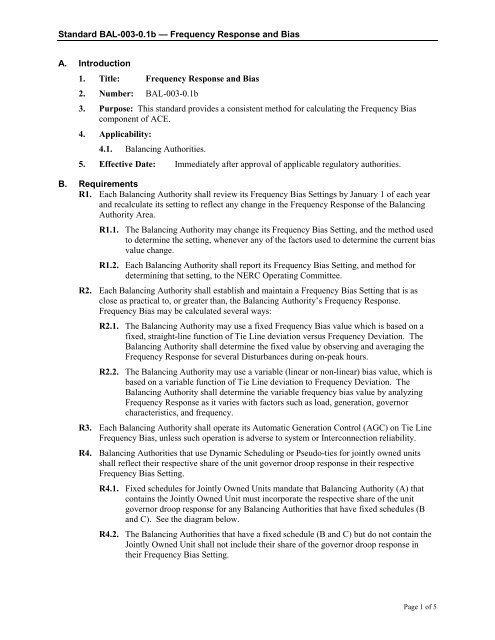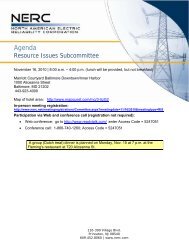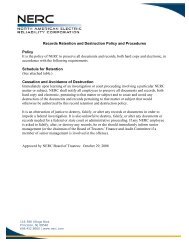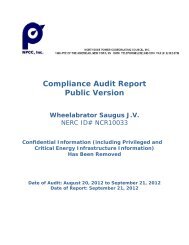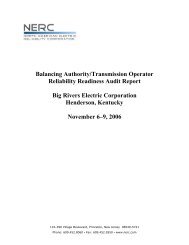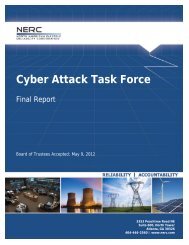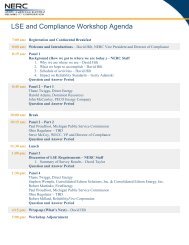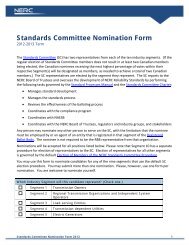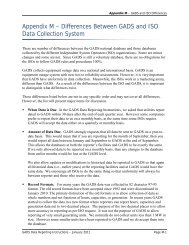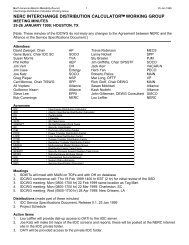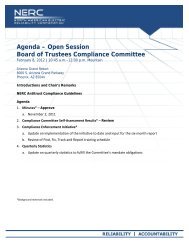Standard BAL-003-0.1b — Frequency Response and Bias A ... - NERC
Standard BAL-003-0.1b — Frequency Response and Bias A ... - NERC
Standard BAL-003-0.1b — Frequency Response and Bias A ... - NERC
Create successful ePaper yourself
Turn your PDF publications into a flip-book with our unique Google optimized e-Paper software.
<strong>St<strong>and</strong>ard</strong> <strong>BAL</strong>-<strong>003</strong>-<strong>0.1b</strong> <strong>—</strong> <strong>Frequency</strong> <strong>Response</strong> <strong>and</strong> <strong>Bias</strong><br />
A. Introduction<br />
1. Title: <strong>Frequency</strong> <strong>Response</strong> <strong>and</strong> <strong>Bias</strong><br />
2. Number: <strong>BAL</strong>-<strong>003</strong>-<strong>0.1b</strong><br />
3. Purpose: This st<strong>and</strong>ard provides a consistent method for calculating the <strong>Frequency</strong> <strong>Bias</strong><br />
component of ACE.<br />
4. Applicability:<br />
4.1. Balancing Authorities.<br />
5. Effective Date: Immediately after approval of applicable regulatory authorities.<br />
B. Requirements<br />
R1. Each Balancing Authority shall review its <strong>Frequency</strong> <strong>Bias</strong> Settings by January 1 of each year<br />
<strong>and</strong> recalculate its setting to reflect any change in the <strong>Frequency</strong> <strong>Response</strong> of the Balancing<br />
Authority Area.<br />
R1.1. The Balancing Authority may change its <strong>Frequency</strong> <strong>Bias</strong> Setting, <strong>and</strong> the method used<br />
to determine the setting, whenever any of the factors used to determine the current bias<br />
value change.<br />
R1.2. Each Balancing Authority shall report its <strong>Frequency</strong> <strong>Bias</strong> Setting, <strong>and</strong> method for<br />
determining that setting, to the <strong>NERC</strong> Operating Committee.<br />
R2. Each Balancing Authority shall establish <strong>and</strong> maintain a <strong>Frequency</strong> <strong>Bias</strong> Setting that is as<br />
close as practical to, or greater than, the Balancing Authority’s <strong>Frequency</strong> <strong>Response</strong>.<br />
<strong>Frequency</strong> <strong>Bias</strong> may be calculated several ways:<br />
R2.1. The Balancing Authority may use a fixed <strong>Frequency</strong> <strong>Bias</strong> value which is based on a<br />
fixed, straight-line function of Tie Line deviation versus <strong>Frequency</strong> Deviation. The<br />
Balancing Authority shall determine the fixed value by observing <strong>and</strong> averaging the<br />
<strong>Frequency</strong> <strong>Response</strong> for several Disturbances during on-peak hours.<br />
R2.2. The Balancing Authority may use a variable (linear or non-linear) bias value, which is<br />
based on a variable function of Tie Line deviation to <strong>Frequency</strong> Deviation. The<br />
Balancing Authority shall determine the variable frequency bias value by analyzing<br />
<strong>Frequency</strong> <strong>Response</strong> as it varies with factors such as load, generation, governor<br />
characteristics, <strong>and</strong> frequency.<br />
R3. Each Balancing Authority shall operate its Automatic Generation Control (AGC) on Tie Line<br />
<strong>Frequency</strong> <strong>Bias</strong>, unless such operation is adverse to system or Interconnection reliability.<br />
R4. Balancing Authorities that use Dynamic Scheduling or Pseudo-ties for jointly owned units<br />
shall reflect their respective share of the unit governor droop response in their respective<br />
<strong>Frequency</strong> <strong>Bias</strong> Setting.<br />
R4.1. Fixed schedules for Jointly Owned Units m<strong>and</strong>ate that Balancing Authority (A) that<br />
contains the Jointly Owned Unit must incorporate the respective share of the unit<br />
governor droop response for any Balancing Authorities that have fixed schedules (B<br />
<strong>and</strong> C). See the diagram below.<br />
R4.2. The Balancing Authorities that have a fixed schedule (B <strong>and</strong> C) but do not contain the<br />
Jointly Owned Unit shall not include their share of the governor droop response in<br />
their <strong>Frequency</strong> <strong>Bias</strong> Setting.<br />
Page 1 of 5
<strong>St<strong>and</strong>ard</strong> <strong>BAL</strong>-<strong>003</strong>-<strong>0.1b</strong> <strong>—</strong> <strong>Frequency</strong> <strong>Response</strong> <strong>and</strong> <strong>Bias</strong><br />
R5. Balancing Authorities that serve native load shall have a monthly average <strong>Frequency</strong> <strong>Bias</strong><br />
Setting that is at least 1% of the Balancing Authority’s estimated yearly peak dem<strong>and</strong> per 0.1<br />
Hz change.<br />
R5.1. Balancing Authorities that do not serve native load shall have a monthly average<br />
<strong>Frequency</strong> <strong>Bias</strong> Setting that is at least 1% of its estimated maximum generation level in<br />
the coming year per 0.1 Hz change.<br />
R6. A Balancing Authority that is performing Overlap Regulation Service shall increase its<br />
<strong>Frequency</strong> <strong>Bias</strong> Setting to match the frequency response of the entire area being controlled. A<br />
Balancing Authority shall not change its <strong>Frequency</strong> <strong>Bias</strong> Setting when performing<br />
Supplemental Regulation Service.<br />
C. Measures<br />
M1. Each Balancing Authority shall perform <strong>Frequency</strong> <strong>Response</strong> surveys when called for by the<br />
Operating Committee to determine the Balancing Authority’s response to Interconnection<br />
<strong>Frequency</strong> Deviations.<br />
D. Compliance<br />
Not Specified.<br />
E. Regional Differences<br />
None identified.<br />
F. Associated Documents<br />
1. Appendix 1 ⎯ Interpretation of Requirement R3 (October 23, 2007).<br />
2. Appendix 2 ⎯ Interpretation of Requirements R2, R2.2, R5, <strong>and</strong> R5.1 (February 12, 2008).<br />
Version History<br />
Jointly Owned Unit<br />
A<br />
B C<br />
Version Date Action Change Tracking<br />
0 April 1, 2005 Effective Date New<br />
0 August 8, 2005 Removed "Proposed" from Effective Date Errata<br />
0 March 16, 2007 FERC Approval <strong>—</strong> Order 693 New<br />
Page 2 of 5
<strong>St<strong>and</strong>ard</strong> <strong>BAL</strong>-<strong>003</strong>-<strong>0.1b</strong> <strong>—</strong> <strong>Frequency</strong> <strong>Response</strong> <strong>and</strong> <strong>Bias</strong><br />
0a December 19, 2007 Added Appendix 1 ⎯ Interpretation of R3<br />
approved by BOT on October 23, 2007<br />
Addition<br />
0a July 21, 2008 FERC Approval of Interpretation of R3 Addition<br />
0b February 12, 2008 Added Appendix 2 ⎯ Interpretation of R2,<br />
R2.2, R5, <strong>and</strong> R5.1 approved by BOT on<br />
February 12, 2008<br />
<strong>0.1b</strong> January 16, 2008 Section F: added “1.”; changed hyphen to “en<br />
dash.” Changed font style for “Appendix 1” to<br />
Arial; updated version number to “<strong>0.1b</strong>”<br />
Addition<br />
Errata<br />
<strong>0.1b</strong> October 29, 2008 BOT approved errata changes Errata<br />
0.1a May 13, 2009 FERC Approved errata changes – version<br />
changed to 0.1a (Interpretation of R2, R2.2,<br />
R5, <strong>and</strong> R5.1 not yet approved)<br />
<strong>0.1b</strong> May 21, 2009 FERC Approved Interpretation of R2, R2.2,<br />
R5, <strong>and</strong> R5.1<br />
Errata<br />
Addition<br />
Page 3 of 5
<strong>St<strong>and</strong>ard</strong> <strong>BAL</strong>-<strong>003</strong>-<strong>0.1b</strong> <strong>—</strong> <strong>Frequency</strong> <strong>Response</strong> <strong>and</strong> <strong>Bias</strong><br />
Interpretation of Requirement 3<br />
Appendix 1<br />
Request: Does the WECC Automatic Time Error Control Procedure (WATEC) violate Requirement 3 of<br />
<strong>BAL</strong>-<strong>003</strong>-0?<br />
Interpretation:<br />
Requirement 3 of <strong>BAL</strong>-<strong>003</strong>-0 <strong>—</strong> <strong>Frequency</strong> <strong>Response</strong> <strong>and</strong> <strong>Bias</strong> deals with Balancing Authorities using<br />
Tie-Line <strong>Frequency</strong> <strong>Bias</strong> as the normal mode of automatic generation control.<br />
<strong>BAL</strong>-<strong>003</strong>-0<br />
R3. Each Balancing Authority shall operate its Automatic Generation Control (AGC) on Tie Line<br />
<strong>Frequency</strong> <strong>Bias</strong>, unless such operation is adverse to system or Interconnection reliability.<br />
Tie-Line <strong>Frequency</strong> <strong>Bias</strong> is one of the three foundational control modes available in a Balancing<br />
Authority’s energy management system. (The other two are flat-tie <strong>and</strong> flat-frequency.) Many Balancing<br />
Authorities layer other control objectives on top of their basic control mode, such as automatic inadvertent<br />
payback, CPS optimization, time control (in single BA Interconnections).<br />
As long as Tie-Line <strong>Frequency</strong> <strong>Bias</strong> is the underlying control mode <strong>and</strong> CPS1 is measured <strong>and</strong> reported<br />
on the associated ACE equation, there is no violation of <strong>BAL</strong>-<strong>003</strong>-0 Requirement 3:<br />
ACE = (NI A − NI S ) – 10B (F A − F S ) − I ME<br />
Page 4 of 5
<strong>St<strong>and</strong>ard</strong> <strong>BAL</strong>-<strong>003</strong>-<strong>0.1b</strong> <strong>—</strong> <strong>Frequency</strong> <strong>Response</strong> <strong>and</strong> <strong>Bias</strong><br />
Appendix 2<br />
Interpretation of Requirements R2, R2.2, R5, R5.1<br />
Request: ERCOT specifically requests clarification that a Balancing Authority is entitled to use a<br />
variable bias value as authorized by Requirement R2.2, even though Requirement 5 seems not to account<br />
for the possibility of variable bias settings.<br />
Interpretation:<br />
The consensus of the Resources Subcommittee is that <strong>BAL</strong>-<strong>003</strong>-0 <strong>—</strong> <strong>Frequency</strong> <strong>Response</strong> <strong>and</strong> <strong>Bias</strong> <strong>—</strong><br />
Requirement R2 does not conflict with <strong>BAL</strong>-<strong>003</strong>-0 Requirement R5.<br />
<strong>BAL</strong>-<strong>003</strong>-0 <strong>—</strong> <strong>Frequency</strong> <strong>Response</strong> <strong>and</strong> <strong>Bias</strong> Requirement 2 requires a Balancing Authority to analyze<br />
its response to frequency excursions as a first step in determining its frequency bias setting. The<br />
Balancing Authority may then choose a fixed bias (constant through the year) per Requirement 2.1, or a<br />
variable bias (varies with load, specific generators, etc.) per Requirement 2.2.<br />
<strong>BAL</strong>-<strong>003</strong>-0<br />
R2. Each Balancing Authority shall establish <strong>and</strong> maintain a <strong>Frequency</strong> <strong>Bias</strong> Setting that is as close<br />
as practical to, or greater than, the Balancing Authority’s <strong>Frequency</strong> <strong>Response</strong>. <strong>Frequency</strong> <strong>Bias</strong><br />
may be calculated several ways:<br />
<strong>BAL</strong>-<strong>003</strong>-0 <strong>—</strong> <strong>Frequency</strong> <strong>Response</strong> <strong>and</strong> <strong>Bias</strong> Requirement 5 sets a minimum contribution for all<br />
Balancing Authorities toward stabilizing interconnection frequency. The 1% bias setting establishes a<br />
minimum level of automatic generation control action to help stabilize frequency following a disturbance.<br />
By setting a floor on bias, Requirement 5 also helps ensure a consistent measure of control performance<br />
among all Balancing Authorities within a multi-Balancing Authority interconnection. However, ERCOT<br />
is a single Balancing Authority interconnection. The bias settings ERCOT uses do produce, on average,<br />
the best level of automatic generation control action to meet control performance metrics. The bias value<br />
in a single Balancing Authority interconnection does not impact the measure of control performance.<br />
<strong>BAL</strong>-<strong>003</strong>-0<br />
R2.1. The Balancing Authority may use a fixed <strong>Frequency</strong> <strong>Bias</strong> value which is based on a<br />
fixed, straight-line function of Tie Line deviation versus <strong>Frequency</strong> Deviation. The<br />
Balancing Authority shall determine the fixed value by observing <strong>and</strong> averaging the<br />
<strong>Frequency</strong> <strong>Response</strong> for several Disturbances during on-peak hours.<br />
R2.2. The Balancing Authority may use a variable (linear or non-linear) bias value, which is<br />
based on a variable function of Tie Line deviation to <strong>Frequency</strong> Deviation. The<br />
Balancing Authority shall determine the variable frequency bias value by analyzing<br />
<strong>Frequency</strong> <strong>Response</strong> as it varies with factors such as load, generation, governor<br />
characteristics, <strong>and</strong> frequency.<br />
R5. Balancing Authorities that serve native load shall have a monthly average <strong>Frequency</strong> <strong>Bias</strong><br />
Setting that is at least 1% of the Balancing Authority’s estimated yearly peak dem<strong>and</strong> per 0.1 Hz<br />
change.<br />
R5.1. Balancing Authorities that do not serve native load shall have a monthly average<br />
<strong>Frequency</strong> <strong>Bias</strong> Setting that is at least 1% of its estimated maximum generation level in<br />
the coming year per 0.1 Hz change.<br />
Page 5 of 5


